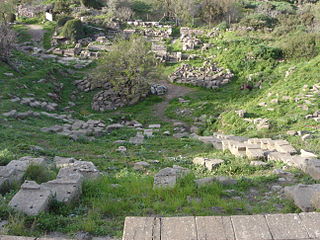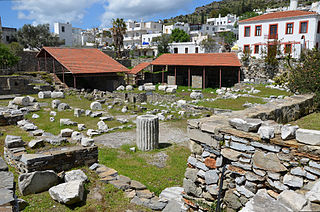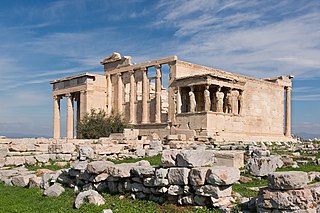
The Acropolis of Athens is an ancient citadel located on a rocky outcrop above the city of Athens, Greece, and contains the remains of several ancient buildings of great architectural and historical significance, the most famous being the Parthenon. The word Acropolis is from the Greek words ἄκρον and πόλις. The term acropolis is generic and there are many other acropoleis in Greece. During ancient times the Acropolis of Athens was also more properly known as Cecropia, after the legendary serpent-man Cecrops, the supposed first Athenian king.

The British Museum is a public museum dedicated to human history, art and culture located in the Bloomsbury area of London. Its permanent collection of eight million works is the largest in the world. It documents the story of human culture from its beginnings to the present. The British Museum was the first public national museum to cover all fields of knowledge.

The Parthenon is a former temple on the Athenian Acropolis, Greece, that was dedicated to the goddess Athena during the fifth century BC. Its decorative sculptures are considered some of the high points of classical Greek art, an enduring symbol of Ancient Greece, democracy, and Western civilization.

The Mausoleum at Halicarnassus or Tomb of Mausolus was a tomb built between 353 and 350 BC in Halicarnassus for Mausolus, an Anatolian from Caria and a satrap in the Achaemenid Empire, and his sister-wife Artemisia II of Caria. The structure was designed by the Greek architects Satyros and Pythius of Priene. Its elevated tomb structure is derived from the tombs of neighbouring Lycia, a territory Mausolus had invaded and annexed c. 360 BC, such as the Nereid Monument.

Erythrae or Erythrai later Litri, was one of the twelve Ionian cities of Asia Minor, situated 22 km north-east of the port of Cyssus, on a small peninsula stretching into the Bay of Erythrae, at an equal distance from the mountains Mimas and Corycus, and directly opposite the island of Chios. It is recorded that excellent wine was produced in the peninsula. Erythrae was notable for being the seat of the Erythraean Sibyl. The ruins of the city are found north of the town Ildırı in the Çeşme district of İzmir Province, Turkey.

Priene was an ancient Greek city of Ionia located at the base of an escarpment of Mycale, about 6 kilometres (3.7 mi) north of what was then the course of the Maeander River. It was 67 kilometres (42 mi) from ancient Anthea, 15 kilometres (9.3 mi) from ancient Aneon and 25 kilometres (16 mi) from ancient Miletus. The city was built on the sea coast, overlooking the former Latmian Gulf of the Aegean. It was developed on steep slopes and terraces extending from sea level to a height of 380 metres (1,250 ft) above sea level at the top of the escarpment. Because of siltation from the river filling the bay over several centuries, the city is now an inland site. It is located at a short distance west of the modern village Güllübahçe Turun in the Söke district of Aydın Province, Turkey.

Halicarnassus was an ancient Greek city in Caria, in Anatolia. It was located in southwest Caria, on an advantageous site on the Gulf of Gökova, which is now in Bodrum, Turkey. The city was famous for the Mausoleum of Halicarnassus, also known simply as the Tomb of Mausolus, whose name provided the origin of the word "mausoleum". The mausoleum, built from 353 to 350 BC, ranked as one of the seven wonders of the ancient world.

The Erechtheion or Temple of Athena Polias is an ancient Greek Ionic temple on the north side of the Acropolis, Athens, which was primarily dedicated to the goddess Athena.

Ancient art refers to the many types of art produced by the advanced cultures of ancient societies with different forms of writing, such as those of ancient China, India, Mesopotamia, Persia, Palestine, Egypt, Greece, and Rome. The art of pre-literate societies is normally referred to as prehistoric art and is not covered here. Although some pre-Columbian cultures developed writing during the centuries before the arrival of Europeans, on grounds of dating these are covered at pre-Columbian art and articles such as Maya art, Aztec art, and Olmec art.

Eretria is a town in Euboea, Greece, facing the coast of Attica across the narrow South Euboean Gulf. It was an important Greek polis in the 6th and 5th century BC, mentioned by many famous writers and actively involved in significant historical events.

The Temple of Athena Nike is a temple on the Acropolis of Athens, dedicated to the goddesses Athena and Nike. Built around 420 BCE, the temple is the earliest fully Ionic temple on the Acropolis. It has a prominent position on a steep bastion at the south west corner of the Acropolis to the right of the entrance, the Propylaea. In contrast to the Acropolis proper, a walled sanctuary entered through the Propylaea, the Victory Sanctuary was open, entered from the Propylaea's southwest wing and from a narrow stair on the north. The sheer walls of its bastion were protected on the north, west, and south by the Nike Parapet, named for its frieze of Nikai celebrating victory and sacrificing to their patroness, Athena and Nike.

Pythius, also known as Pytheos or Pythis, was a Greek architect, architecture theorist, and sculptor of the 4th century BC. He designed the Temple of Athena Polias at Priene and the Mausoleum at Halicarnassus, which was regarded in antiquity among the Seven Wonders of the World. It is presumed that he came from the Greek city of Priene. The first-century BC Roman architect Vitruvius called Pythius a "celebrated builder" and referenced lost treatises on architecture written in Greek by Pythius as sources for his Latin architecture manual de Architectura (I.1.15).

Rhamnous, also Ramnous or Rhamnus, was an ancient Greek city in Attica situated on the coast, overlooking the Euboean Strait. Its ruins lie northwest of the modern town of Agia Marina in the municipality of Marathon.

The Old Temple of Athena or the Archaios Neos was an archaic Greek limestone Doric temple on the Acropolis of Athens probably built in the second half of the sixth-century BCE, and which housed the xoanon of Athena Polias. The existence of an archaic temple to Athena had long been conjectured from literary references until the discovery of substantial building foundations under the raised terrace between the Erechtheion and Parthenon in 1886 confirmed it. While it is uncontroversial that a temple stood on the central acropolis terrace in the late archaic period and was burnt down in the Persian invasion of 480, nevertheless questions of its nature, name, reconstruction and duration remain unresolved.

The Hekatompedon or Hekatompedos, also known as Ur-Parthenon and H–Architektur, was an ancient Greek temple on the Acropolis of Athens built from limestone in the Archaic period, and placed in the position of the present Parthenon.

The Lion of Knidos is the name for a colossal ancient Greek statue erected near the ancient port of Knidos, south-west Asia Minor. Although there is some debate about the age of the sculpture, in general, scholarly opinion dates it to the 2nd century BC. Since 2000, it has been prominently displayed on a plinth under the roof of the Queen Elizabeth II Great Court because soon after it was seen by British archaeologists in 1858, the statue was taken by the British to London where it became part of the British Museum's collection.

Ancient Greek art stands out among that of other ancient cultures for its development of naturalistic but idealized depictions of the human body, in which largely nude male figures were generally the focus of innovation. The rate of stylistic development between about 750 and 300 BC was remarkable by ancient standards, and in surviving works is best seen in sculpture. There were important innovations in painting, which have to be essentially reconstructed due to the lack of original survivals of quality, other than the distinct field of painted pottery.

The Temple of Poseidon is an ancient Greek temple on Cape Sounion, Greece, dedicated to the god Poseidon. There is evidence of the establishment of sanctuaries on the cape from as early as the 11th century BC. Sounion's most prominent temples, the Temple of Athena and the Temple of Poseidon, are however not believed to have been built until about 700 BC, and their kouroi date from about one hundred years later. The material and size of the offerings at the Temple of Poseidon indicate that it was likely frequented by members of the elite and the aristocratic class.

The Temple of Athena Polias in Priene was an Ionic Order temple located northwest of Priene’s agora, inside the sanctuary complex. It was dedicated to Athena Polias, also the patron deity of Athens. It was the main temple in Priene, although there was a temple of Zeus. Built around 350 BC, its construction was sponsored by Alexander the Great during his anabasis to the Persian Empire. Its ruins sit at the foot of an escarpment of mount Mycale. It was believed to have been constructed and designed by Pytheos, who was the architect of the great Mausoleum of Halikarnassos, one of the Seven Wonders of the Ancient World. It was one of the Hellenistic temples that was not reconstructed by Romans.
Alexander the Great issued an edict, probably in the summer of 334 BC, to the city of Priene. On the Temple of Athena Polias a section of the edict was inscribed across four marble blocks "near the top of the east face of the north anta of the pronaos." It was inscribed in Koine Greek the 280s BC during the reign of Lysimachus. The same engraver inscribed a decree and letter of Lysimachus. Above the edict is the temple's dedicatory inscription in the Ionic dialect, which was erected by Alexander himself. All these inscriptions are now in the British Museum.


















